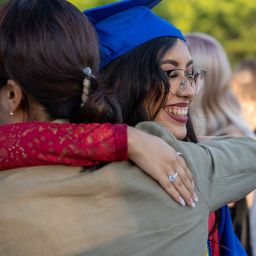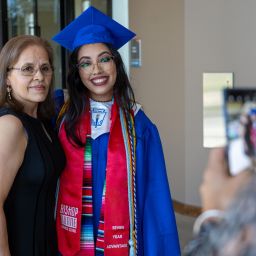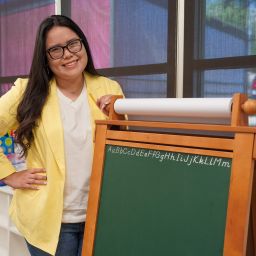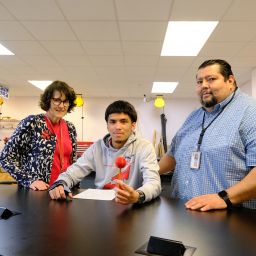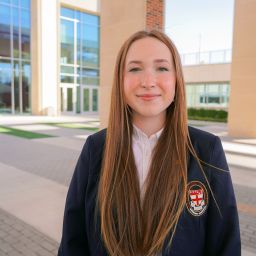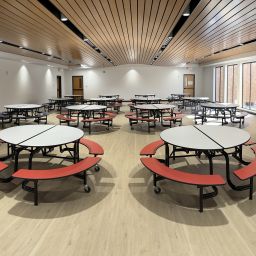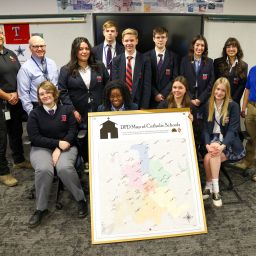
Victoria Gonzalez, left, and Nefeli Chokas, both kindergarteners at Holy Trinity Catholic School, work on a project to show their appreciation for principal Kaitlyn Aguilar during Haley Boudreaux’s STREAM class on Jan. 19. (Michael Gresham/The Texas Catholic)
By Michael Gresham
The Texas Catholic
With the observance of Catholic Schools Week each year, communities take time to celebrate all that endears them to their Catholic school — faith, fellowship, and academic success.
One aspect that makes Holy Trinity Catholic School special to its community is its focus on its “specials,” a term principal Kaitlyn Aguilar uses to describe the school’s co-curricular classes.
“It’s our commitment to developing the unique, God-given talents of all our students,” Aguilar said. “We want to expose our students to opportunities they may not have had otherwise so that they get to learn what they’re good at or try something new that maybe they’re not good at, but they experience and appreciate. Our specials allow us to do just that.”
Those specials classes include art, music, Spanish, physical education, library, and STREAM (Science, Technology, Religion, Engineering, Art, and Math). Aguilar said the school places extra emphasis on including such classes in its curriculum despite its somewhat smaller school size.
“We have 167 students in the school. That’s one class per grade level,” Aguilar said. “And we have five specials teachers.”
It is not typical for smaller schools to have that many teachers for specials, according to Aguilar. It is something, however, she believes to be important to Holy Trinity’s mission.
“To me, it’s important to offer these opportunities because not every child is going to excel at reading or math, but they do have something to contribute to our world,” Aguilar said. “God has a plan for them, and the more we can help them develop all those skills, the better they can understand the gifts God has given them.”
Aguilar added that she believes such co-curricular classes help prepare students for the real world.
“Our world has changed so drastically,” she explained. “There is no way we can know what kinds of jobs we are preparing our children for, but we want to prepare them with a wide array of skills and with the ability to be able to think, problem solve, and work together in teams. Our co-curricular and extra-curricular programs allow for that development.”

A talented team
According to Aguilar, what makes those specials classes even more special are the educators who lead them, including music teacher Glorimary Rivera, Spanish teacher Marta Munoz, physical education teacher Willie Thomas, art teacher Michelle Marzen, and librarian/technology teacher Haley Boudreaux.
“We have an amazing team of educators in our specials classes who are offering so many opportunities to our students that extend beyond just the classroom,” Aguilar said. “For example, just look at what Coach Thomas does — he gets every kid participating in a variety of sports. Typically, when you think of PE, you think of basketball, volleyball, soccer, etc. Archery. Bowling. Golf. Pickleball. They may not all be great at these sports, but he’s helping them understand more of a healthy lifestyle and exposing them to different things.”
Thomas added that students benefit from his classes by learning more about physical activity and physical fitness.
“The class gives students the ability and confidence to be physically active for a lifetime. Students develop motor skills. Students are able to express themselves in class activities,” he said. “Physical education benefits students mind, body and spirit. Students are able to improve cardio and learn many different activities.”
Munoz has been teaching at Holy Trinity for 25 years. In her Spanish classes, she teaches not only a new language but also helps students from pre-K3 to eighth grade understand culture and diversity.
“One of the most important benefits I believe of learning a foreign language at an early age is that it will give students the opportunity to learn about other cultures, helping to understand the cultures around them and easily make a connection with language being learned,” Munoz said. “Every year we celebrate the feast of Our Lady of Guadalupe, Dia de Muertos, and las posadas as part of our Christmas program. These are experiences that students participate in to learn more about cultural traditions, grow their faith, and practice the religion they profess.”
Rivera, who is in her seventh year of teaching music at Holy Trinity, said she believes elementary and middle school are vital learning years in a student’s life.
“The kids start exploring the world, what they like, and begin to discover and to show their talents,” said Rivera, a 17-year veteran educator. “Giving the students the opportunity to have not only one but various special classes open the possibilities of finding their true passion.”
Speaking specifically about music, Rivera noted that it has been scientifically proven that working memory, selective attention, cognitive flexibility, and inhibitions are challenged while developing skills in playing musical instruments, singing, or dancing. At Holy Trinity, students can join choir and band as extracurricular activities.
“However, all my students from pre-K3 through eighth grade have the opportunity to discover and to appreciate the music during my class,” Rivera said. “With each of my classes, I try to pass on the love for music and the happiness it brings with it. And, of course, I always try to teach them that the gift of the music comes from God.”
Marzen, who is in her first year of teaching at Holy Trinity, called art a creative outlet for students, adding that she looks to make her lessons more than just “arts and crafts.”
“I also draw connections between art and history,” Marzen said. “I like to introduce students to more interesting methods of creating art than just painting and drawing; though paint and pencil are excellent mediums through which students can learn and master foundational techniques, there is a wealth of applications that are not normally covered in the average art class.”
Marzen added that she wants students to realize that art does not exist in a bubble.
“There are so many ways to be artistic and creative and integrate that into other subjects and areas in life,” she explained. “While I encourage students to look outward and see beyond the art in front of them, I also encourage them to look inwards at themselves and who they are at heart.”
As the school’s STREAM teacher, Boudreaux believes the opportunity for students to participate in various special classes is beneficial to their learning development.
“It allows them to explore new ideas and learn new problem-solving strategies,” she said, adding that her goal as a STREAM teacher is to help develop independent thinkers who are unafraid to make mistakes. “We try to celebrate the process of learning as much as a result or finished project.”
With her classes, Boudreaux strives to show students how what they learn connects to the real world. In a recent lesson, she had students do a self-evaluation of their own executive function skills.
“I introduced how our brain is responsible for each, and we discussed definitions and examples of each one,” she said. “I did this with second through eighth grade, and we gathered some interesting data, including what executive functions each class and the entire school needs help with the most. This understanding of brain science benefits them in every academic class, at home, in sports, and with their own self-esteem.”
Ultimately, what these teachers and their classes provide the students is an extension of the mission of Catholic schools, Aguilar said.
“As Catholic schools, we talk about different styles of learners. We talk about meeting them where they are. With these classes, we are doing that, and I think that’s what makes them special.”

